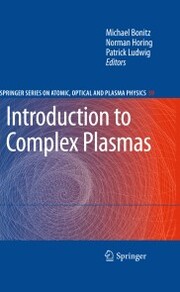Detailansicht
Introduction to Complex Plasmas
eBook - Springer Series on Atomic, Optical, and Plasma Physics
ISBN/EAN: 9783642105920
Umbreit-Nr.: 1702255
Sprache:
Englisch
Umfang: 450 S., 11.67 MB
Format in cm:
Einband:
Keine Angabe
Erschienen am 29.07.2010
Auflage: 1/2010
E-Book
Format: PDF
DRM: Digitales Wasserzeichen
- Zusatztext
- <P>Complex plasmas differ from traditional plasmas in many ways: these are low-temperature high pressure systems containing nanometer to micrometer size particles which may be highly charged and strongly interacting. The particles may be chemically reacting or be in contact with solid surfaces, and the electrons may show quantum behaviour. These interesting properties have led to many applications of complex plasmas in technology, medicine and science.</P><P>Yet complex plasmas are extremely complicated, both experimentally and theoretically, and require a variety of new approaches which go beyond standard plasma physics courses. This book fills this gap presenting an introduction to theory, experiment and computer simulation in this field. Based on tutorial lectures at a very successful recent Summer Institute, the presentation is ideally suited for graduate students, plasma physicists and experienced undergraduates.</P>
- Kurztext
- Complex plasmas differ from traditional plasmas in many ways: there are low-temperature high pressure systems containing nanometer to micrometer size particles which may be highly charged and strongly interacting. The particles may be chamically reacting or be in contact with solid surfaces, and the electrons may show quantum behaviour. These interesting properties have led to many applications of complex plasmas in technology, medicine and science. Yet complex plasmas are extremely complicated, both experimentally and theoretically, and require a variety of new approaches which go beyond standard plasma physics courses. This book fills this gap presenting an introduction to theory, experiment and computer simulation in this field. Based on tutorial lectures at a very successful recent Summer Institute, the presentation is ideally suited for graduate students, plasma physicists and experienced undergraduates.
